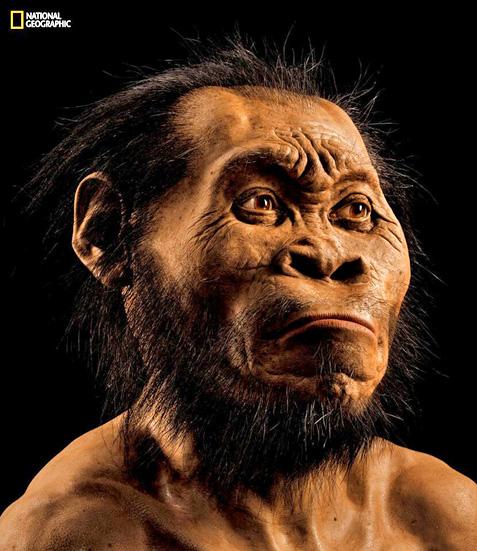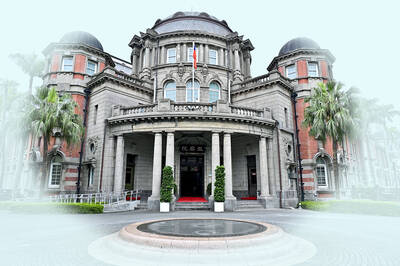Acting on a tip from spelunkers two years ago, scientists in South Africa discovered what the cavers had only dimly glimpsed through a crack in a limestone wall deep in the Rising Star Cave: lots and lots of old bones.
The remains covered the earthen floor beyond the narrow opening. This was, the scientists concluded, a large, dark chamber for the dead of a previously unidentified species of the early human lineage — Homo naledi.
The new hominin species was announced Thursday by an international team of more than 60 scientists led by Lee Berger, a US paleoanthropologist who is a professor of human evolution studies at the University of the Witwatersrand in Johannesburg. The species name, H naledi, refers to the cave where the bones lay undisturbed for so long; “naledi” means “star” in the local Sesotho language.

Photo: AFP Photo/Ho/National Geographic/Mark Thiessen
LARGE FIND, BIG CHALLENGE
In two papers published this week in the open-access journal eLife, the researchers said that the more than 1,550 fossil elements documenting the discovery constituted the largest sample for any hominin species in a single African site, and one of the largest anywhere in the world. Further, the scientists said, that sample is probably a small fraction of the fossils yet to be recovered from the chamber. So far the team has recovered parts of at least 15 individuals.
“With almost every bone in the body represented multiple times, Homo naledi is already practically the best-known fossil member of our lineage,” Berger said.

Photo: AFP photo/Ho/ University of Winsconsin-Madison/John Hawks
The finding, like so many others in science, was the result of pure luck followed by considerable effort.
Two local cavers, Rick Hunter and Steven Tucker, found the narrow entrance to the chamber, measuring no more than 7 1/2 inches wide. They were skinny enough to squeeze through, and in the light of their headlamps they saw the bones all around them. When they showed the fossil pictures to Pedro Boshoff, a caver who is also a geologist, he alerted Berger, who organized an investigation.
Just getting into the chamber and bringing out samples proved to be a huge challenge. The narrow opening was the only way in. Paul Dirks, a geologist at James Cook University in Australia, who was lead author of the journal paper describing the chamber, said the investigators first had a steep climb up a stone block called the Dragon’s Back and then a drop down to the entrance passage — all of this in the total absence of natural light.
For the two extended investigations of the chamber in 2013 and last year, Berger rounded up the international team of scientists and then recruited six excavating scientists through notices on social media. One special requirement: They had to be slender enough to crawl through that crack in the wall.
‘UNDERGROUND ASTRONAUTS’
One of the six, who were all women and were called “underground astronauts,” was Marina Elliott of Simon Fraser University in British Columbia. She said the collection and removal of the fossils involved “some of the most difficult and dangerous conditions ever encountered in the search for human origins.”
Besides introducing a new member of the prehuman family, the discovery suggests that some early hominins intentionally deposited bodies of their dead in a remote and largely inaccessible cave chamber, a behavior previously considered limited to modern humans. Some of the scientists referred to the practice as a ritualized treatment of their dead, but by “ritual” they said they meant a deliberate and repeated practice, not necessarily a kind of religious rite.
“It’s very, very fascinating,” said Ian Tattersall, an authority on human evolution at the American Museum of Natural History in New York, who was not involved in the research. “No question there’s at least one new species here,” he added, “but there may be debate over the Homo designation, though the species is quite different from anything else we have seen.”
A colleague of Tattersall’s at the museum, Eric Delson, who is a professor at Lehman College of the City University of New York, was also impressed, saying, “Berger does it again!”
Delson was referring to Berger’s previous headline discovery, published in 2010, also involving cave deposits near Johannesburg. He found many fewer fossils that time, but enough to conclude that he was looking at a new species, which he named Australopithecus sediba. Geologists said the individuals lived 1.78 million to 1.95 million years ago, when australopithecines and early species of Homo were contemporaries.
Researchers analyzing the H. naledi fossils have not yet nailed down their age, which is difficult to measure because of the muddled chamber sediments and the absence of other fauna remains nearby. Some of its primitive anatomy, like a brain no larger than an average orange, Berger said, indicated that the species evolved near or at the root of the Homo genus, meaning it must be in excess of 2.5 million to 2.8 million years old. Geologists think the cave is no older than 3 million years.

That US assistance was a model for Taiwan’s spectacular development success was early recognized by policymakers and analysts. In a report to the US Congress for the fiscal year 1962, former President John F. Kennedy noted Taiwan’s “rapid economic growth,” was “producing a substantial net gain in living.” Kennedy had a stake in Taiwan’s achievements and the US’ official development assistance (ODA) in general: In September 1961, his entreaty to make the 1960s a “decade of development,” and an accompanying proposal for dedicated legislation to this end, had been formalized by congressional passage of the Foreign Assistance Act. Two

Despite the intense sunshine, we were hardly breaking a sweat as we cruised along the flat, dedicated bike lane, well protected from the heat by a canopy of trees. The electric assist on the bikes likely made a difference, too. Far removed from the bustle and noise of the Taichung traffic, we admired the serene rural scenery, making our way over rivers, alongside rice paddies and through pear orchards. Our route for the day covered two bike paths that connect in Fengyuan District (豐原) and are best done together. The Hou-Feng Bike Path (后豐鐵馬道) runs southward from Houli District (后里) while the

The Taipei Times last week reported that the Control Yuan said it had been “left with no choice” but to ask the Constitutional Court to rule on the constitutionality of the central government budget, which left it without a budget. Lost in the outrage over the cuts to defense and to the Constitutional Court were the cuts to the Control Yuan, whose operating budget was slashed by 96 percent. It is unable even to pay its utility bills, and in the press conference it convened on the issue, said that its department directors were paying out of pocket for gasoline

On March 13 President William Lai (賴清德) gave a national security speech noting the 20th year since the passing of China’s Anti-Secession Law (反分裂國家法) in March 2005 that laid the legal groundwork for an invasion of Taiwan. That law, and other subsequent ones, are merely political theater created by the Chinese Communist Party (CCP) to have something to point to so they can claim “we have to do it, it is the law.” The president’s speech was somber and said: “By its actions, China already satisfies the definition of a ‘foreign hostile force’ as provided in the Anti-Infiltration Act, which unlike